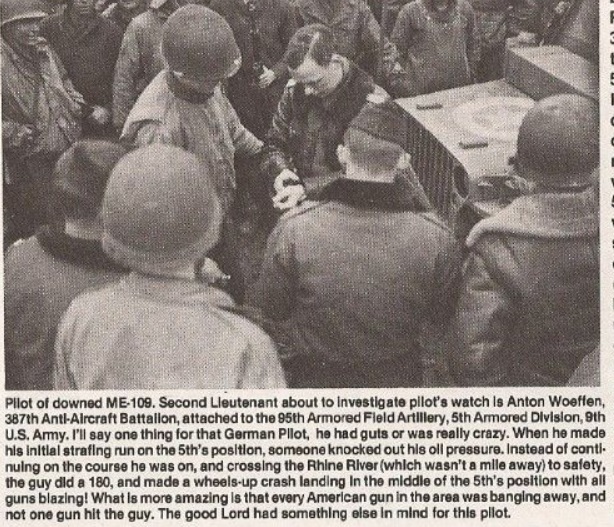Anton Wöffen's 'yellow 24' a 6./ JG 27 Bf 109 G-10 WNr. 490655 after being shot down on March 11, 1945 at Xanten, on the western bank of the river Rhine close to the Dutch border between Nijmegen and Duisberg. The pilot was taken captive, below.
Above; US signals photo
Wöffen’s memoir ‘Ich war kein Jagdflieger As - Erinnerungen eines unbekannten Jagdfliegers’ ( '..recollections of an unknown fighter pilot' ) was ‘serialised’ in Jägerblatt during 1983 and later translated and published in Finland.
"..it is nearly forty years since I last flew a Bf 109 Gustav ..March 11, 1945. That clear sunny Sunday morning I was tasked as Staffelführer with leading a Schwarm of four 6./JG 27 Bf 109s up from Hopsten near Rheine on a recce sortie in the sector Wesel-Rheinberg-Duisberg where German troops still held a bridgehead on the western bank of the Rhine. There were signs that the Americans were preparing an all-out assault and I had to ascertain more - a somewhat hopeless task. But then at that time so much appeared to be hopeless and pointless. Should we encounter artillery ranging and spotting machines in the air then we were authorised to shoot them down. Such machines were making life very difficult for our troops on the ground. Once airborne we flew at tree-top height in the direction of the river Rhine - skipping over trees, streetlights and houses we had to fly very carefully to avoid contact with obstacles. This was especially the case for those of my comrades flying behind the Verbandsführer (formation leader). Even for myself it was not easy to navigate at such low altitudes. At 500 km/h - the sort of speeds we could attain with full armament in normal flight - you could not see much at all. Moments after arriving over Wesel I spotted an 'Auster' climbing at about 100 meters altitude directly ahead of me. What then followed, happened very quickly.. I flicked up the armament safety catch on the control column for the 2cm cannon and the two cowl MG 131s and pulling up under the enemy machine gave the Auster a burst from all three guns. Suddenly I felt a blow in the engine. The prop continued to spin - but at a much reduced rate of revolutions. Smoke started to seep into the cockpit. I continued to climb hoping to reach a 'safe' altitude to bail out but my speed was decreasing far too quickly. I could see tracers from all sides rising towards me and immediately pushed the nose down. I had arrived directly over the American lines. I could see fire coming from an anti-aircraft battery and, taking aim in so far as I could, gave the Amis on the ground a burst of fire. By now I was approaching the ground and, although the smoke was hampering my efforts, prepared for a crash-landing..I saw high tension wires flitting past the cockpit ..above my head. I pulled back hard on the stick. The machine hit the ground with an almighty crash and bumping and jolting slid along for some distance. Suddenly everything went quiet. I opened the hood and climbed out. I had made a perfect belly landing and had escaped completely unscathed. I had been lucky. Just thirty meters in front of me was a railway embankment which I could just as easily have plowed into. Running towards me from all directions were American soldiers. Standing on the port wing I leaned back into the cockpit and as I started to tear up my map I heard loud shouting behind me..." Hands up!"





